- europages
- >
- COMPANIES - SUPPLIERS - SERVICE PROVIDERS
- >
- tightening clamps
Results for
Tightening clamps - Import export

NORELEM FRANCE
France
1. Screw the locking screw into the collar bush, fixture clamp and clamping unit and screw onto the baseplate. 2. The workpiece is clamped by tightening the fixture clamp with a spanner. Advantages: Compact design Quick and easy clamping of components Pull-down effect Drawing reference: 1) Locking screw 2) Collar bush 3) Fixture clamp 4) Clamping unit
Request for a quote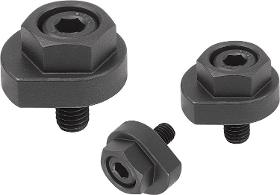
NORELEM FRANCE
France
1. Screw the locking screw into the collar bush and fixture clamp and screw onto the baseplate. 2. The workpiece is clamped by tightening the fixture clamp with a spanner. Advantages: Compact design Quick and easy clamping of components Drawing reference: 1) Locking screw 2) Collar bush 3) Fixture clamp
Request for a quote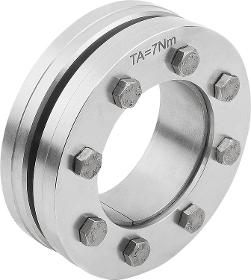
NORELEM FRANCE
France
Shrink disc to connect a hollow hub to a shaft. They are mounted on the OD of the hub and generate pressure on the hub wall by reducing the ID with wedgeformed rings, creating a press fit between the hub and shaft. They are suitable for static, dynamic and shock loads. for extremely high torques no axial shaft/hub offset when assembling selfcentring The version 23380014072 has high tensile ISO 4762 screws. Assembly Remove existing transportation locks. Clean and lightly oil shaft, internal and external hub diameters. Do not use MoS2 or grease. Slide shrink disc onto hub. Then slide unit (shrink disc/hub) onto shaft and position correctly. Gently tighten clamping screws one after the other by hand. Then use a torque wrench to tighten the clamping screws crosswise in several increments to the defined tightening torque MS. 1st increment approx. 33% MS 2nd increment approx. 66% MS
Request for a quote
NORELEM FRANCE
France
The lateral clamping screw tightens the jaws and clamps the workpiece on the circumference. The simple and compact design allows 2 workpieces to be clamped. The clamping travel is max. 0.5 mm. The jaws must be pre-tensioned before machining the contour, the supplied clamping ring is used for this purpose.
Request for a quote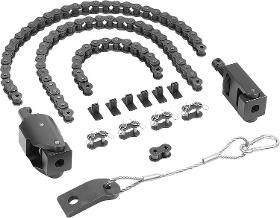
NORELEM FRANCE
France
Chain clamps are used mainly in machine and plant construction. Chain clamps enable cylindrical, complicated and large to very large workpieces to be clamped securely and effectively in the quickest and easiest way. Suitable for cylindrical workpieces, valve bodies, pistons etc. The workpiece surface can be protected by attaching the plastic elements. Application: The knurled nut on the clamping bracket can be used to preset the chain length and the clamping force. The required torque is set on the clamping hook. Accessory: Steel roller chains for chain clamp sets 04211-03. Steel turnbuckles for chain clamp sets 04211-06. Steel prisms for chain clamp sets 04211-09. Nuts for T-slots DIN 508 enhanced, 07060. Cap screws DIN EN ISO 4762, 07160. Note: The opening angle of the chain should not exceed 30°. Do not exceed max. permitted tightening torques. Supplied with Chain clamp set 04211-15: Clamping hook. Clamping bracket.
Request for a quoteDo you sell or make similar products?
Sign up to europages and have your products listed
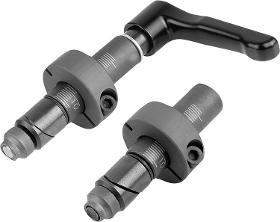
NORELEM FRANCE
France
The screw is tightened or the clamping lever is turned to expand the two wedges in the hole. The infinitely adjustable shaft collar enables one or more stop elements with various thicknesses to be securely fixated. Application: These clamping pins are perfect for fixing standard stop elements with various thicknesses to hole grid boards / welding tables with hole Ø 16 mm or 28 mm. Advantages: Infinitely adjustable clamping range of 0-36 mm and 0-75 mm. Not affected by the diameter or surface quality of the bore (up to H12). Clamping range can be easily preset using the scale. Gentle clamping in the bore. Pull-down effect even with thin table material (≥8 mm or ≥4 mm). Compatible with conventional stop elements.
Request for a quote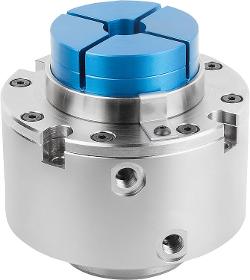
NORELEM FRANCE
France
The collet is opened by applying compressed air to the "open" port. The collet is closed (for clamping) by applying compressed air to the "close" port. The pneumatic connections can be screwed on either from below or from the side. If the air is connected from below, the side ports must be closed. Machining the collet for external clamping: The negative form of the workpiece to be clamped is machined into the collet. Free-form and asymmetrical contours are possible. Different workpieces can be clamped quickly and securely by simply exchanging the collet. The collet can be milled down to height H2. This enables multiple workpiece contours to be machined into one collet. Repeat accuracy for workpiece: +/-0.03 Repeat accuracy after replacing the collet +/- 0.02 The collet radial clamping travel is 0.15 mm per clamping segment. To prevent damage the collet should not be tightened without a workpiece or clamping ring in place. The operating air pressure should lay between 0.45 - 0.55 MPa.
Request for a quoteResults for
Tightening clamps - Import exportNumber of results
8 ProductsCompany type